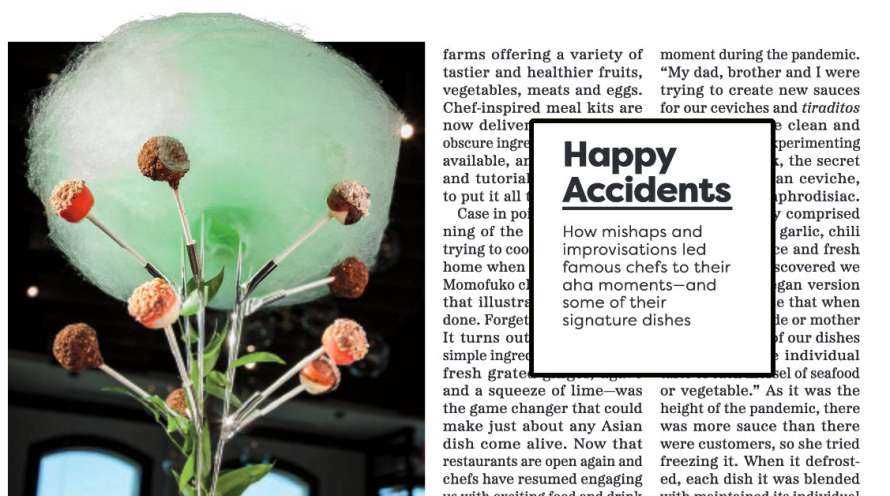How mishaps and improvisations led famous chefs to their aha moments—and some of their signature dishes
Chef/restaurateur David Burke, a frequent competitor on Top Chef Masters and owner of 15 restaurants across the country, recalls his surprising patented dry-age process for beef. “I wanted to find a dry-aged flavor that enhanced my beef, so I sent a rib eye to the lab to analyze. About four months later my buddy at the lab called to tell me the rib eye had 340 different flavor compounds. Then he stunned me by stating the number-one flavor profile was cardboard.
Cardboard! Where was that coming from? I went to the dry-aging room and saw the floor was covered with—cardboard. A light bulb went on as I realized that as its moisture evaporated, the rib eye was absorbing the flavor of that cardboard and would likely do the same with any flavor introduced in the cooler. Then I thought about salt, which usually seasons steak when it’s finished cooking. Why not season it from within by having the meat absorb its flavors in the cooler? “A block of pink Himalayan salt had been sitting on my desk for a while,” he continues. “I knew it had more complex flavors than regular salt, and that could benefit the aging process. So I lined the whole cooler with pink Himalayan salt blocks, and it created amazing flavor. Now I hold a U.S. patent for my salt-based dry-aging process for beef, and our guests can’t get enough of the umami flavor.”
Chef Burke goes on to describe his second game changer, gourmet lollipops. “I was recently divorced and rarely ate a real meal at home, so there was nothing much in the refrigerator except some shards of my salmon pastrami and cream cheese. My two kids were coming to visit and I wondered if I could trick them into eating something other than fast food with what I had on hand. I had just bought some lollipop molds at a garage sale and had a drawer full of sticks left over from something or other. I combined the salmon and the cream cheese and pureed them into a paste. The paste went into small round molds, and then got placed on a stick. After the lollipops firmed up in the fridge, I presented them to the boys. They wouldn’t eat them, but I knew I was onto something. They would make a great hors d’oeuvre and lead to a line of savory gourmet pops. Then I thought I could create dessert pops that would have broader appeal, which became my cheesecake pops, now a signature dessert at most of my restaurants.”
Excerpt from article in Business Traveler. To read entire article online, click here.

